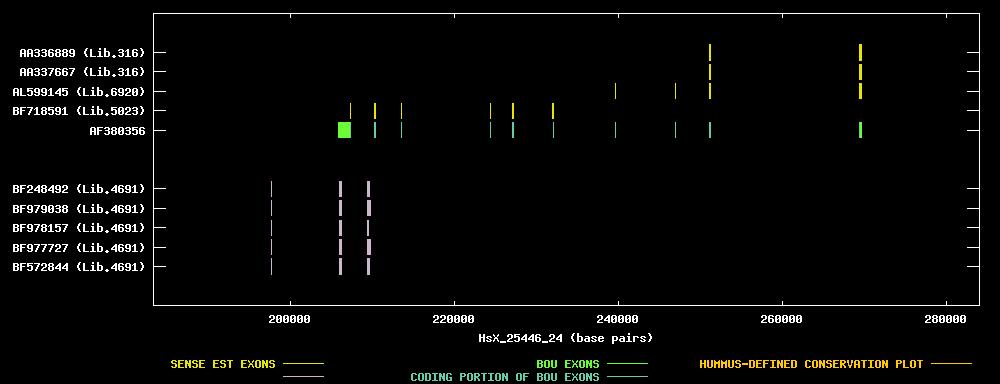SENSE ESTs




| Candidate UniGene cluster: | UniGene Cluster Hs.38774 |
| Description: | Homo sapiens PBDX-like protein mRNA, complete cds |
| Best-Of-UniGene (BOU) Sequence | AF380356 |
| Genomic Coordiantes Displayed: | Bases 183301 to 284073 of contig HsX_25446_24 |
| BOU Orientation Along Contig: | RIGHT-TO-LEFT with respect to contig |
| Link to JPEG of genomic mapping | Hs.38774.jpeg |
| Best sense EST/protein match: | AF380356 matched sp|P55808|XG_HUMAN XG GLYCOPROTEIN PRECURSOR (PROTEIN PBDX) (E = 3e-59) |
| Best antisense EST/protein match: | No protein match with an e-value of less than 1e-10 |

ANTISENSE ESTs
| BF248492 | cDNA clone IMAGE:4046178 | melanotic melanoma, high mdr | 5' read | |||
| BF979038 | cDNA clone IMAGE:4306688 | melanotic melanoma, high mdr | 5' read | |||
| BF978157 | cDNA clone IMAGE:4307181 | melanotic melanoma, high mdr | 5' read | |||
| BF977727 | cDNA clone IMAGE:4307506 | melanotic melanoma, high mdr | 5' read | |||
| BF572844 | cDNA clone IMAGE:4253978 | melanotic melanoma, high mdr | 5' read |
| BF718591 | cDNA clone S90328.NIH436-R | epidermis | 3' read |  | ||
| AL599145 | cDNA clone DKFZp313L1624 | 5' read |  | |||
| AA337667 | cDNA clone ATCC:139418 | uterus | 5' read |  | ||
| AA336889 | cDNA clone ATCC:138633 | uterus | 5' read |  |